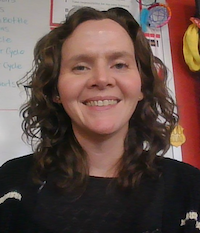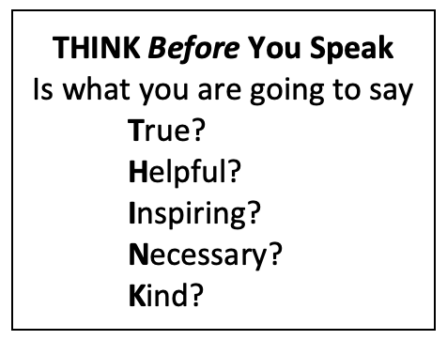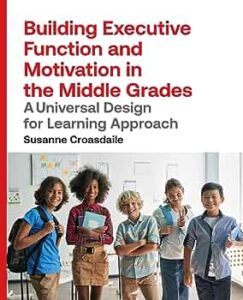A UDL Strategy to Help Students Communicate
By Samantha Layne and Susanne Croasdaile

Samantha
If there’s one thing we talk about all the time in the hallway, it’s how unkind the students sound when they talk with one another!
Though not a new issue, it sure does make it tough to build a positive tone in the classroom and develop a sense of community.

Susanne
We continually remind ourselves that we must teach behavior the same way we teach academics: model it, use strategy instruction, and intentionally plan the First 20 Days of class to build habits and routines.
But we’re not going to lie: we sure would like to wave a magic wand and make it easier to have instant classroom community!
Join us for a quick classroom observation. As the bell rings, seventh graders slowly find their seats in a science classroom. As in previous sessions, we start class with both PBIS expectations and a learning target.
But students still walk into class making unpleasant comments and using an aggressive tone with each other – and with the adults in the room! How do we get to a classroom community centered in positive communication and collaboration? We wondered:
• Why is their tone so harsh and aggressive with each other…and with us?
• We’ve been doing so many things…why isn’t our classroom community “jelling”?
Here’s where we need the UDL Cautious Corner
In our school, we use a Universal Design for Learning (UDL) lens for teaching and learning, which means we consider our classroom challenges using the UDL framework. When we look at the lower-right side of the UDL Guidelines 2.0, we see what we call the “Cautious Corner” of UDL – Guidelines 6, 8, and 9.
How students choose their words and control their verbal tone falls in this “cautious corner” of skills that won’t fully develop until students complete their neural development – around age 25! That means social interactions will be hit-or-miss for another decade after they leave us. We have to explicitly teach and scaffold the skills the entire time they are with us in middle school.
(source)
Why else is verbal tone important? Achieving collaboration and community (UDL Guideline 8) is an important part of developing internalized motivation – which inspires students to come back to school each day and engage in learning.
Students are social beings and motivated by positive interactions (and unmotivated by negative ones), so collaboration and community are critical areas of focus for educators. Our challenges with negative tone and unkind words could lead to some of our students not engaging…and others just staying home.
People who communicate effectively learned it from someone
People don’t learn how to communicate appropriately without explicit instruction; we just think they do. When we see students speaking appropriately and working successfully with others, it’s important to know that some person took the time to model it or teach it, perhaps intentionally, and the student learned it and internalized it. For other students, it’s our responsibility to teach it.
We need to avoid the trap of thinking that children are naturally good at talking and working with their peers. Remember William Golding’s Lord of the Flies? Supposedly the author was reading an unrealistic bedtime story to the children and said to his wife, “Wouldn’t it be a good idea if I wrote a book about children stranded on an island, children who behave in the way children really would behave?”
We understand. When we don’t teach prosocial skills intentionally and explicitly, some students certainly don’t find them on their own. In our classrooms we need to carefully plan and structure positive peer interactions. We also have to monitor how students are doing and adjust if they’re not hanging in there.
But aren’t I doing all of these things already?
Step back into our classroom with us. From day 1 we had students engaged in daily review of the TRIBE PBIS expectations (Teamwork, Respond appropriately, Integrity, Be kind, Excellence). We chose focus areas for the day based on either previous classes or the way students entered the room.
Some days the students were able to pick their area to work on along with the given community goal for the day. Every day the community goal was “Be kind, and in the classroom you show this by using positive language and comments.”
At the end of class there was time given for students to debrief and reflect on how they did with the behavior expectations. Reflection was done on both an individual level (e.g., Thumb-O-Meter) and on a community level.
Small improvements emerged, but not enough. Why weren’t they getting better at positive communication?
We had implemented our First 20 Days strategies like Think-Pair, Notice and Wonder, Share What Others Said and Accountable Talk with sentence starters and stems, and as we said, started the class with behavior and learning expectations.
Using a Y-Chart before moving into tough parts of certain lessons helped, but the climate in the room was still negative and more time was being spent on disruptive behaviors than learning.
Here were the trouble spots:
• verbal tone was harsh and aggressive toward each other and the teacher
• students and the community struggled with Think-Pair
• talking over each other and blurting across the classroom
We were spending more time on redirection and resolving conflicts than students spent on learning. (Sound familiar?) It felt like when one verbal distraction was resolved, another one was starting.
The redirection was always, “Be kind by using positive language and comments.” We explained that the classroom community was different from other places where they might hang out and interact with each other: Some words are OK in those places but not OK in our classroom community.
Teach behavior skills the way you teach academic skills
Based on where the students were, we planned a next step to teach behavior skills the same way we teach academics. We knew we needed a way for students to think before they spoke, so we decided on a popular mnemonic strategy: T-H-I-N-K.
We had the students repeat the acronym (THINK: True, Helpful, Inspiring, Necessary, Kind) at the start of each class while behavior and learning expectations were reviewed. We explained that all things being said in the classroom had to fit into all of THINK.
We modeled and scaffolded, giving examples of words and phrases that did and didn’t fit into THINK, always redirecting with “Please THINK about the things you are saying in our community.”

When the teacher went over the behavior expectations at the start of class, several students would give a look of exhaustion and say “Mrs. Layne, do we need to say this every class?” The reply was “yes,” and it felt like a win because students really were “THINKing” before they were speaking!
Persistence with academic behaviors leads to academic progress
The slow start at the beginning of class was going to help us move quicker with our learning because students had a tool to help them talk nicely to each other, which meant they could engage in discourse to learn science.
Middle grades learners thrive with clear and consistent expectations. We used precious minutes at the beginning of the year to front-load strategies like Think-Pair and THINK during the First 20 Days. Those things take time to teach and can cause us to fall behind in content pacing, but they are community builders that give time back later in the school year.
The teacher can move quicker through content because students know how to speak to one another and work with each other in the classroom.
Yes, the classroom is still loud and sometimes chaotic, but students are using and reminding each other to use THINK and their other strategies. The students are engaging in more learning time and less time is spent on negative verbal distractions.
Because we approach teaching and learning through a UDL lens, we understand and accept that we have to explicitly teach and scaffold the skills the entire time they are with us in middle school.
So, start slowly to teach, practice and use strategies so that you can move fast through the content. Take it from Samantha: “I’m very passionate about structure and routine and consistency, to the point where I think my students are annoyed by it by the end of the year, which means I’ve done my job!”
(Source: Edutopia)
Samantha Layne has been a middle and high school science teacher with extensive experience teaching English language learners and students with disabilities. She has served as a department chair and on the school leadership team. She is a national professional developer for the University of Kansas Center for Research on Learning’s Strategic Instruction Model and currently leads a school-based peer coaching team. Samantha also provides professional learning support to teachers who are developing a school-based curriculum.

Susanne has been a classroom teacher, instructional coach, professional developer, program specialist, systems change consultant, and associate director of curriculum and instruction for public schools in Virginia and Louisiana.
































